Life Cycle Cost Assessment of Electric Vehicles: A Review and Bibliometric Analysis
Abstract
1. Introduction
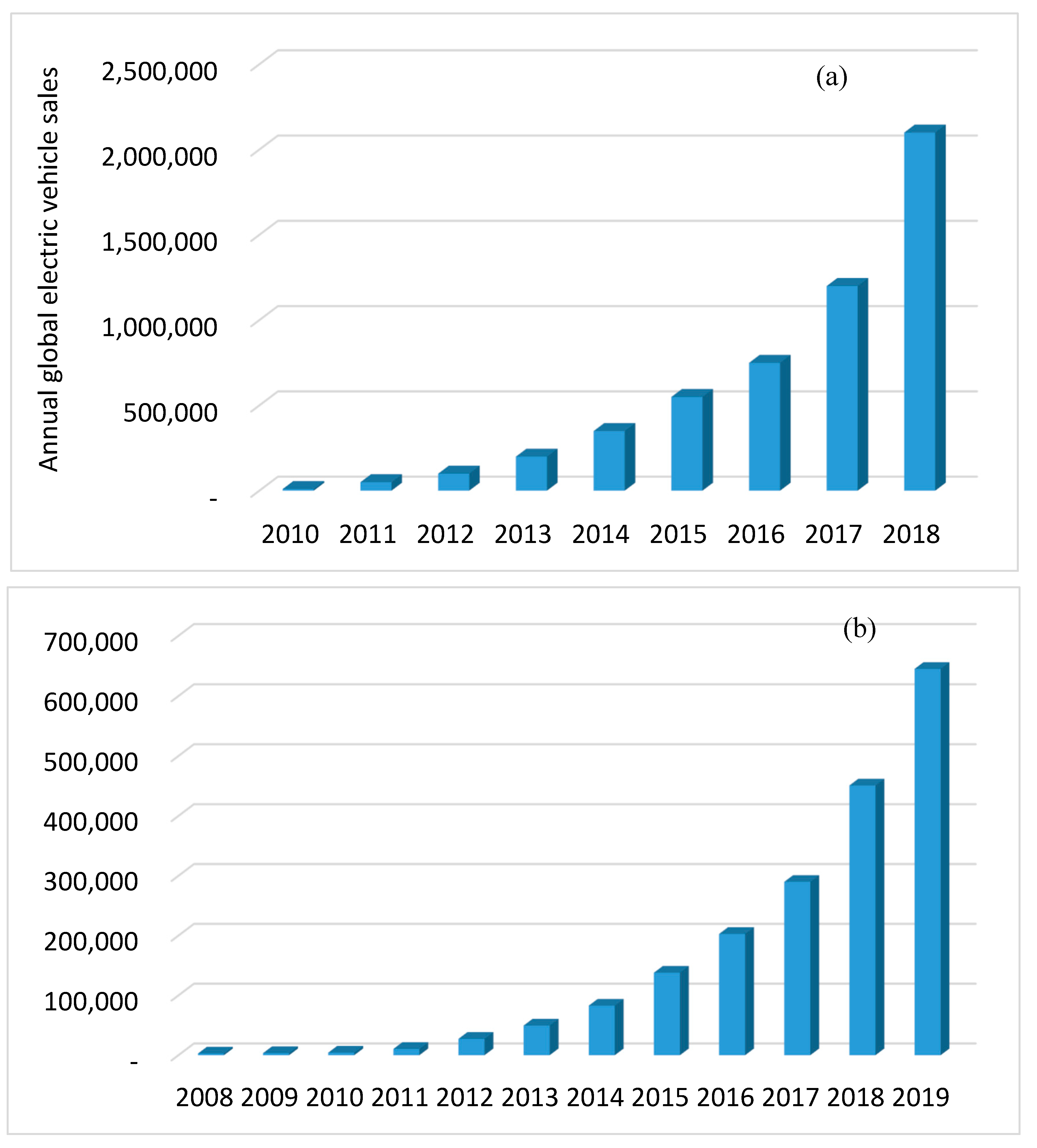
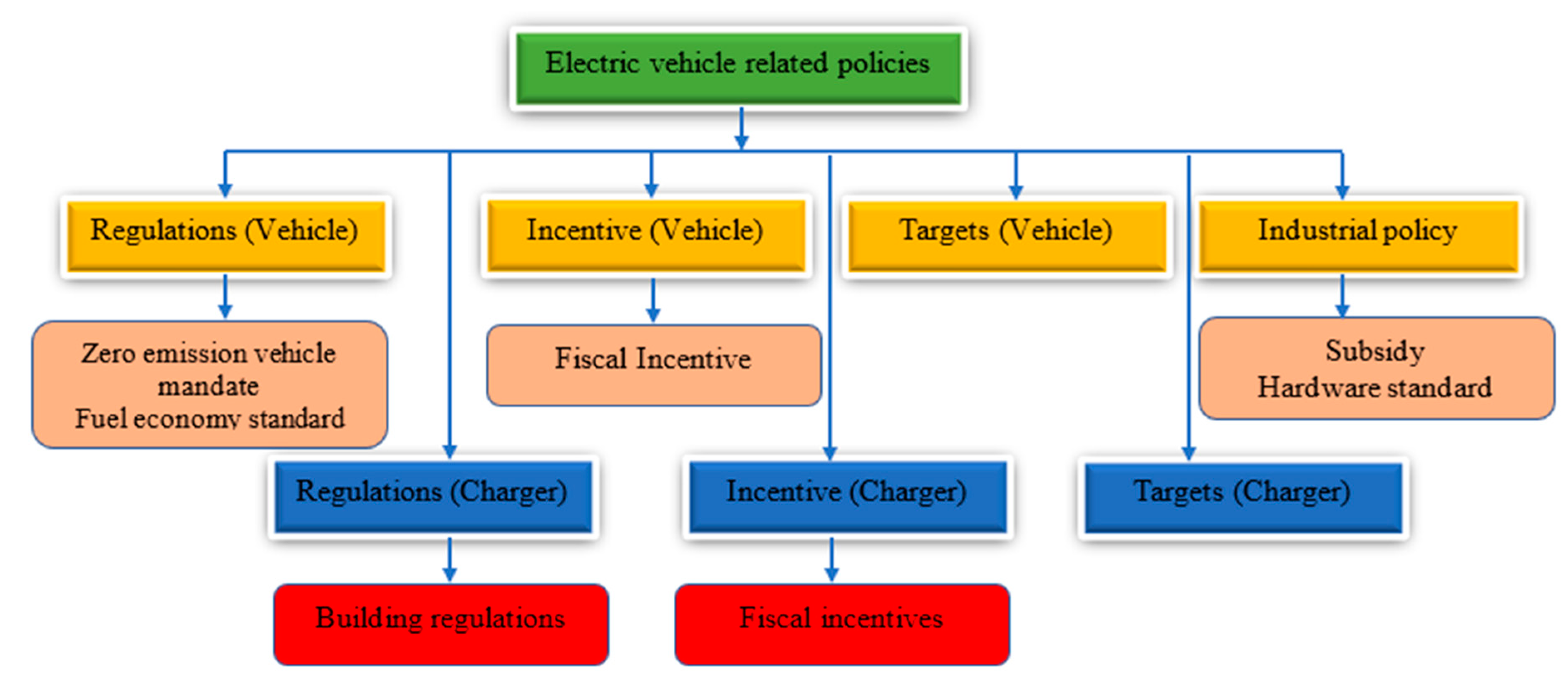
Overview of Different Life Cycle Cost Frameworksfor Electric Vehicles
2. Review Methodology
2.1. Review Approach
2.2. Review Planning
2.3. Conducting the Review
2.4. Bibliometric Analysis
3. Results and Discussion
3.1. Time Trend of Publications
3.2. Geographical Distribution of the Published Articles on LCC of EVs
3.3. Journal Analysis
3.4. Comparison of the LCC of the Different EV Model
3.5. Bibliometric Analysis Using VOSviewer
4. Implications of the Study in Terms of Existing Policies and Legislations
5. Conclusions and Future Outlook
Author Contributions
Funding
Acknowledgments
Conflicts of Interest
References
- Hofer, C.; Jäger, G.; Füllsack, M. Large scale simulation of CO2 emissions caused by urban car traffic: An agent-based network approach. J. Clean. Prod. 2018, 183, 1–10. [Google Scholar] [CrossRef]
- Keller, V.; Lyseng, B.; Wade, C.; Scholtysik, S.; Fowler, M.; Donald, J.; Palmer-Wilson, K.; Robertson, B.; Wild, P.; Rowe, A. Electricity system and emission impact of direct and indirect electrification of heavy-duty transportation. Energy 2019, 172, 740–751. [Google Scholar] [CrossRef]
- Du, H.; Chen, Z.; Peng, B.; Southworth, F.; Ma, S.; Wang, Y. What drives CO2 emissions from the transport sector? A linkage analysis. Energy 2019, 175, 195–204. [Google Scholar] [CrossRef]
- Kalghatgi, G. Is it really the end of internal combustion engines and petroleum in transport? Appl. Energy 2018, 225, 965–974. [Google Scholar] [CrossRef]
- Wanitschke, A.; Hoffmann, S. Are battery electric vehicles the future? An uncertainty comparison with hydrogen and combustion engines. Environ. Innov. Soc. Transit. 2019, 1–15. Available online: https://doi.org/10.1016/j.eist.2019.03.003 (accessed on 10 December 2019). [CrossRef]
- Shi, S.; Zhang, H.; Yang, W.; Zhang, Q.; Wang, X. A life-cycle assessment of battery electric and internal combustion engine vehicles: A case in Hebei Province, China. J. Clean. Prod. 2019, 228, 606–618. [Google Scholar] [CrossRef]
- Tartakovsky, L.; Sheintuch, M. Fuel reforming in internal combustion engines. Prog. Energy Combust. Sci. 2018, 67, 88–114. [Google Scholar] [CrossRef]
- Sindhu, R.; Binod, P.; Pandey, A.; Ankaram, S.; Duan, Y.; Awasthi, M.K. Biofuel Production from Biomass: Towards Sustainable Development. In Current Developments in Biotechnology and Bioengineering; Elsevier, 2019; pp. 79–92. Available online: https://www.elsevier.com/books/current-developments-in-biotechnology-and-bioengineering/larroche/978-0-444-63663-8 (accessed on 10 December 2019).
- De Souza, L.L.P.; Lora, E.E.S.; Palacio, J.C.E.; Rocha, M.H.; Renó, M.L.G.; Venturini, O.J. Comparative environmental life cycle assessment of conventional vehicles with different fuel options, plug-in hybrid and electric vehicles for a sustainable transportation system in Brazil. J. Clean. Prod. 2018, 203, 444–468. [Google Scholar] [CrossRef]
- Sharma, A.; Strezov, V. Life cycle environmental and economic impact assessment of alternative transport fuels and power-train technologies. Energy 2017, 133, 1132–1141. [Google Scholar] [CrossRef]
- Bicer, Y.; Dincer, I. Life cycle environmental impact assessments and comparisons of alternative fuels for clean vehicles. Resour. Conserv. Recycl. 2018, 132, 141–157. [Google Scholar] [CrossRef]
- Ozbilen, A.; Dincer, I.; Hosseini, M. Comparative Life Cycle Environmental Impact Assessment of Natural Gas and Conventional Vehicles. In Exergetic, Energetic and Environmental Dimensions; Dincer, I., Colpan, C.O., Kizilkan, O., Eds.; Academic Press: Cambridge, MA, USA, 2018; pp. 913–934. [Google Scholar]
- Kormos, C.; Axsen, J.; Long, Z.; Goldberg, S. Latent demand for zero-emissions vehicles in Canada (Part 2): Insights from a stated choice experiment. Transp. Res. Part D Transp. Environ. 2019, 67, 685–702. [Google Scholar] [CrossRef]
- International Energy Agency. Global EV Outlook 2019 Launched at Clean Energy Ministerial Report. 2019. Available online: https://www.iea.org/news/global-ev-outlook-2019-launched-at-clean-energy-ministerial (accessed on 10 December 2019).
- Feng, X.; Ouyang, M.; Liu, X.; Lu, L.; Xia, Y.; He, X. Thermal runaway mechanism of lithium ion battery for electric vehicles: A review. Energy Storage Mater. 2018, 10, 246–267. [Google Scholar] [CrossRef]
- Adnan, N.; Nordin, S.M.; Rahman, I.; Vasant, P.; Noor, M.A. An overview of electric vehicle technology: A vision towards sustainable transportation. In Intelligent Transportation and Planning; IGI Global: Hershey, PA, USA, 2018; pp. 292–309. [Google Scholar]
- Lane, B.W.; Dumortier, J.; Carley, S.; Siddiki, S.; Clark-Sutton, K.; Graham, J.D. All plug-in electric vehicles are not the same: Predictors of preference for a plug-in hybrid versus a battery-electric vehicle. Transp. Res. Part D Transp. Environ. 2018, 65, 1–13. [Google Scholar] [CrossRef]
- Liu, Z.; Hao, H.; Cheng, X.; Zhao, F. Critical issues of energy efficient and new energy vehicles development in China. Energy Policy 2018, 115, 92–97. [Google Scholar] [CrossRef]
- Wu, Z.; Wang, M.; Zheng, J.; Sun, X.; Zhao, M.; Wang, X. Life cycle greenhouse gas emission reduction potential of battery electric vehicle. J. Clean. Prod. 2018, 190, 462–470. [Google Scholar] [CrossRef]
- Islam, H.; Jollands, M.; Setunge, S. Life cycle assessment and life cycle cost implication of residential buildings—A review. Renew. Sustain. Energy Rev. 2015, 42, 129–140. [Google Scholar] [CrossRef]
- Babashamsi, P.; Md Yusoff, N.I.; Ceylan, H.; Md Nor, N.G.; Salarzadeh Jenatabadi, H. Evaluation of pavement life cycle cost analysis: Review and analysis. Int. J. Pavement Res. Technol. 2016, 9, 241–254. [Google Scholar] [CrossRef]
- Li, J.; Xiao, F.; Zhang, L.; Amirkhanian, S.N. Life cycle assessment and life cycle cost analysis of recycled solid waste materials in highway pavement: A review. J. Clean. Prod. 2019, 233, 1182–1206. [Google Scholar] [CrossRef]
- EAFO. European Alternative Fuels Observatory. 2019. Available online: https://www.eafo.eu/countries/greece/1735/vehicles-and-fleet (accessed on 10 December 2019).
- Diao, Q.; Sun, W.; Yuan, X.; Li, L.; Zheng, Z. Life-cycle private-cost-based competitiveness analysis of electric vehicles in China considering the intangible cost of traffic policies. Appl. Energy 2016, 178, 567–578. [Google Scholar] [CrossRef]
- Kara, S.; Li, W.; Sadjiva, N. Life Cycle Cost Analysis of Electrical Vehicles in Australia. Procedia CIRP 2017, 61, 767–772. [Google Scholar] [CrossRef]
- Lin, C.; Wu, T.; Ou, X.; Zhang, Q.; Zhang, X.; Zhang, X. Life-cycle private costs of hybrid electric vehicles in the current Chinese market. Energy Policy 2013, 55, 501–510. [Google Scholar] [CrossRef]
- Pullin, A.S.; Stewart, G.B. Guidelines for systematic review in conservation and environmental management. Conserv. Biol. 2006, 20, 1647–1656. [Google Scholar] [CrossRef] [PubMed]
- Costa, D.; Quinteiro, P.; Dias, A.C. A systematic review of life cycle sustainability assessment: Current state, methodological challenges, and implementation issues. Sci. Total Environ. 2019, 686, 774–787. [Google Scholar] [CrossRef] [PubMed]
- Fahimnia, B.; Sarkis, J.; Davarzani, H. Green supply chain management: A review and bibliometric analysis. Int. J. Prod. Econ. 2015, 162, 101–114. [Google Scholar] [CrossRef]
- Akmal, A.; Podgorodnichenko, N.; Greatbanks, R.; Everett, A.M. Bibliometric analysis of production planning and control (1990–2016). Prod. Plan. Control 2018, 29, 333–351. [Google Scholar] [CrossRef]
- Castillo-Vergara, M.; Alvarez-Marin, A.; Placencio-Hidalgo, D. A bibliometric analysis of creativity in the field of business economics. J. Bus. Res. 2018, 85, 1–9. [Google Scholar] [CrossRef]
- Sweileh, W.M.; Al-Jabi, S.W.; Zyoud, S.H.; Sawalha, A.F. Outdoor air pollution and respiratory health: A bibliometric analysis of publications in peer-reviewed journals (1900–2017). Multidiscip. Respir. Med. 2018, 13, 1–12. [Google Scholar] [CrossRef]
- Ozbay, K.; Jawad, D.; Parker, N.A.; Hussain, S. Life-cycle cost analysis: State of the practice versus state of the art. Transp. Res. Rec. 2004, 1864, 62–70. [Google Scholar] [CrossRef]
- Karabasoglu, O.; Michalek, J. Influence of driving patterns on life cycle cost and emissions of hybrid and plug-in electric vehicle powertrains. Energy Policy 2013, 60, 445–461. [Google Scholar] [CrossRef]
- Propfe, B.; Redelbach, M.; Santini, D.J.; Friedrich, H. Cost analysis of plug-in hybrid electric vehicles including maintenance & repair costs and resale values. World Electr. Veh. J. 2012, 5, 886–895. [Google Scholar]
- Freire, F.; Marques, P. Electric vehicles in Portugal: An integrated energy, greenhouse gas and cost life-cycle analysis. In Proceedings of the 2012 IEEE International Symposium on Sustainable Systems and Technology (ISSST), Boston, MA, USA, 16–18 May 2012; pp. 1–6. [Google Scholar]
- Wong, Y.S.; Lu, W.F.; Wang, Z. Life cycle cost analysis of different vehicle technologies in Singapore. World Electr. Veh. J. 2011, 4, 912–920. [Google Scholar] [CrossRef]
- Lajunen, A. Energy consumption and cost-benefit analysis of hybrid and electric city buses. Transp. Res. Part C Emerg. Technol. 2014, 38, 1–15. [Google Scholar] [CrossRef]
- Sen, B.; Ercan, T.; Tatari, O. Does a battery-electric truck make a difference?—Life cycle emissions, costs, and externality analysis of alternative fuel-powered Class 8 heavy-duty trucks in the United States. J. Clean. Prod. 2017, 141, 110–121. [Google Scholar] [CrossRef]
- Zhao, X.; Doering, O.C.; Tyner, W.E. The economic competitiveness and emissions of battery electric vehicles in China. Appl. Energy 2015, 156, 666–675. [Google Scholar] [CrossRef]
- Noori, M.; Gardner, S.; Tatari, O. Electric vehicle cost, emissions, and water footprint in the United States: Development of a regional optimization model. Energy 2015, 89, 610–625. [Google Scholar] [CrossRef]
- Hao, H.; Cheng, X.; Liu, Z.; Zhao, F. Electric vehicles for greenhouse gas reduction in China: A cost-effectiveness analysis. Transp. Res. Part D Transp. Environ. 2017, 56, 68–84. [Google Scholar] [CrossRef]
- Jacobs, W.; Hodkiewicz, M.R.; Bräunl, T. A Cost-Benefit Analysis of Electric Loaders to Reduce Diesel Emissions in Underground Hard Rock Mines. IEEE Trans. Ind. Appl. 2015, 51, 2565–2573. [Google Scholar] [CrossRef]
- He, Y.; Zhang, Q.; Pang, Y. The development pattern design of Chinese electric vehicles based on the analysis of the critical price of the life cycle cost. Energy Policy 2017, 109, 382–388. [Google Scholar] [CrossRef]
- Li, X.; Tan, Y.; Liu, X.; Liao, Q.; Sun, B.; Cao, G.; Li, C.; Yang, X.; Wang, Z. A cost-benefit analysis of V2G electric vehicles supporting peak shaving in Shanghai. Electr. Power Syst. Res. 2020, 179, 106058. [Google Scholar] [CrossRef]
- Moon, S.; Lee, D.J. An optimal electric vehicle investment model for consumers using total cost of ownership: A real option approach. Appl. Energy 2019, 253, 113494. [Google Scholar] [CrossRef]
- Mitropoulos, L.K.; Prevedouros, P.D.; Kopelias, P. Total cost of ownership and externalities of conventional, hybrid and electric vehicle. Transp. Res. Procedia 2017, 24, 267–274. [Google Scholar] [CrossRef]
- Palmer, K.; Tate, J.E.; Wadud, Z.; Nellthorp, J. Total cost of ownership and market share for hybrid and electric vehicles in the UK, US and Japan. Appl. Energy 2018, 209, 108–119. [Google Scholar] [CrossRef]
- Zhang, X.; Liang, Y.; Yu, E.; Rao, R.; Xie, J. Review of electric vehicle policies in China: Content summary and effect analysis. Renew. Sustain. Energy Rev. 2017, 70, 698–714. [Google Scholar] [CrossRef]
- Weldu, Y.W. A Societal Life Cycle Costing of Energy Production: The Implications of Environmental Externalities. In Low Carbon Transition-Technical; Silva, V., Ed.; Econ. Policy Assess.; Intechopen: London, UK, 2018; pp. 109–122. [Google Scholar] [CrossRef]
- AECOM. Economic Viability of Electric Vehicles; AECOM: Sydney, Australia, 2009. Available online: https://www.environment.nsw.gov.au/resources/climatechange/ElectricVehiclesReport.pdf (accessed on 7 January 2020).
- Bakker, D. Battery Electric Vehicles: Performance, CO2 Emissions, Lifecycle Costs and Advanced Battery Technology Development; University of Utrcht: Utrecht, The Netherlands, 2010. [Google Scholar]
- Crist, P. Electric Vehicles Revisited: Costs, Subsidies and Prospects. In International Transport Forum Discussion Papers; OECD iLibrary, 2012; Available online: https://doi.org/10.1787/5k8zvv7h9lq7-en (accessed on 7 January 2020).
- EPRI. Total Cost of Ownership Model for Current Plug-in Electric Vehicles; EPRI: California, CA, USA, 2013. [Google Scholar]
- Bascur, J.P.; van Eck, N.J.; Waltman, L. An interactive visual tool for scientific literature search: Proposal and algorithmic specification. CEUR Workshop Proc. 2019, 2345, 76–87. [Google Scholar]
- Zhou, X.; Zou, L.; Ma, Y.; Gao, Z.; Wu, Y.; Yin, J.; Xu, X. The current research on electric vehicle. In Proceedings of the 2016 Chinese Control and Decision Conference (CCDC), Yinchuan, China, 28–30 May 2016; pp. 5190–5194. [Google Scholar] [CrossRef]
- Korosec, K. GM, LG Chem to invest $2.3 billion in EV battery joint venture. Techcrunch 2019, 3. Available online: https://techcrunch.com/2019/12/05/gm-lg-chem-to-invest-2-3-billion-to-in-ev-battery-joint-venture/ (accessed on 7 January 2020).
- International Energy Agency. Policies and Legislation on Hybrid and Electric Vehicles. Hybrid Electr Veh Technol Collab Program. 2020. Available online: http://www.ieahev.org/ (accessed on 10 December 2019).
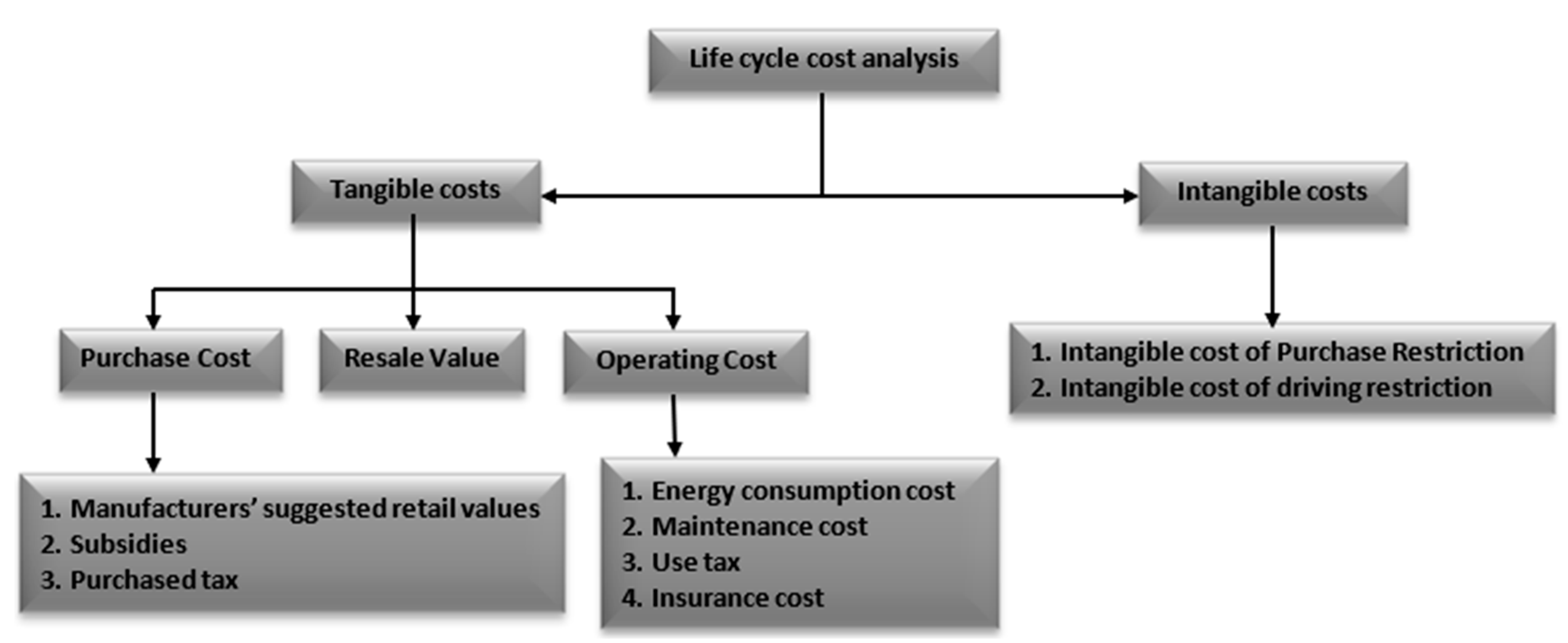
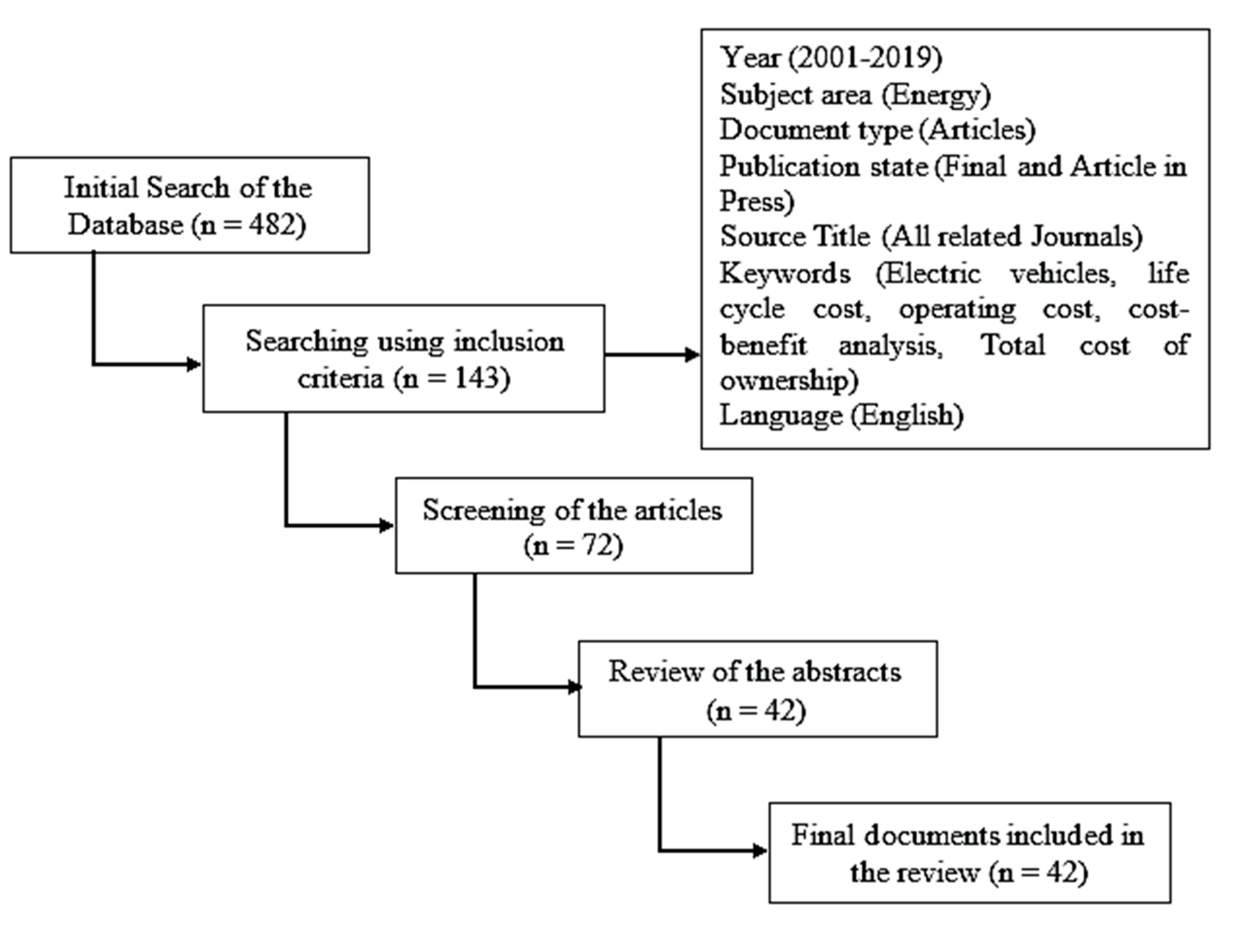
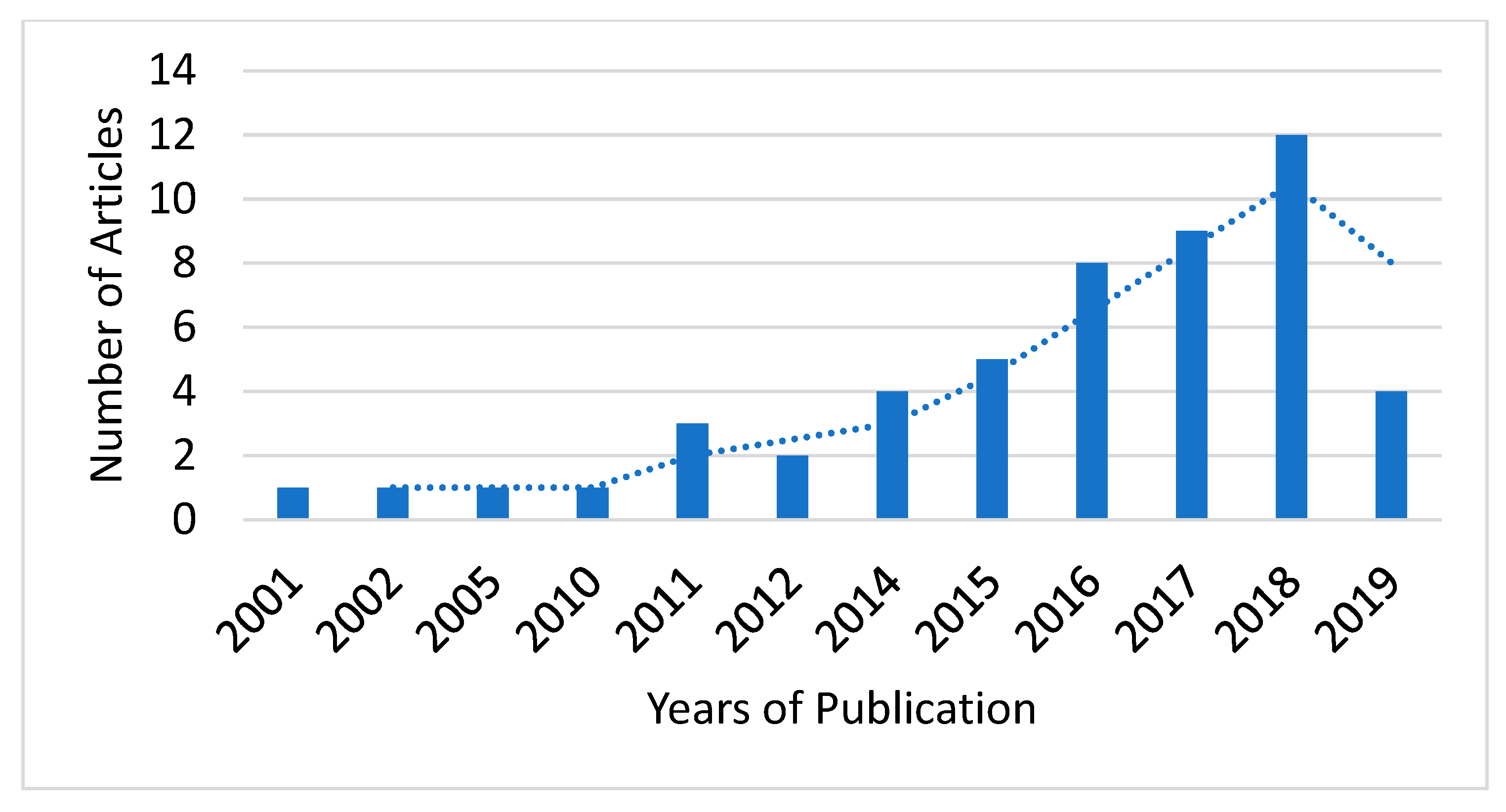
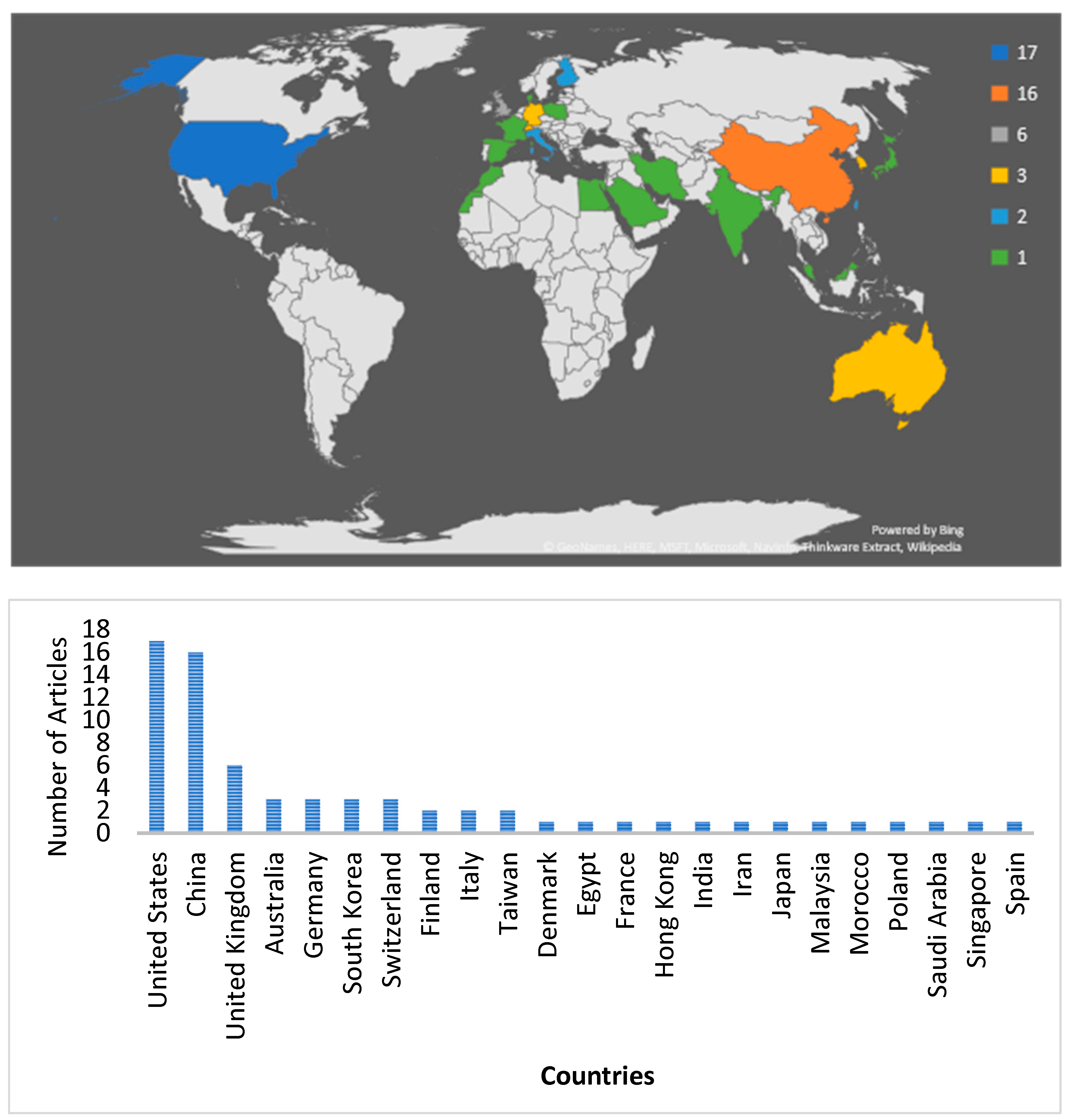
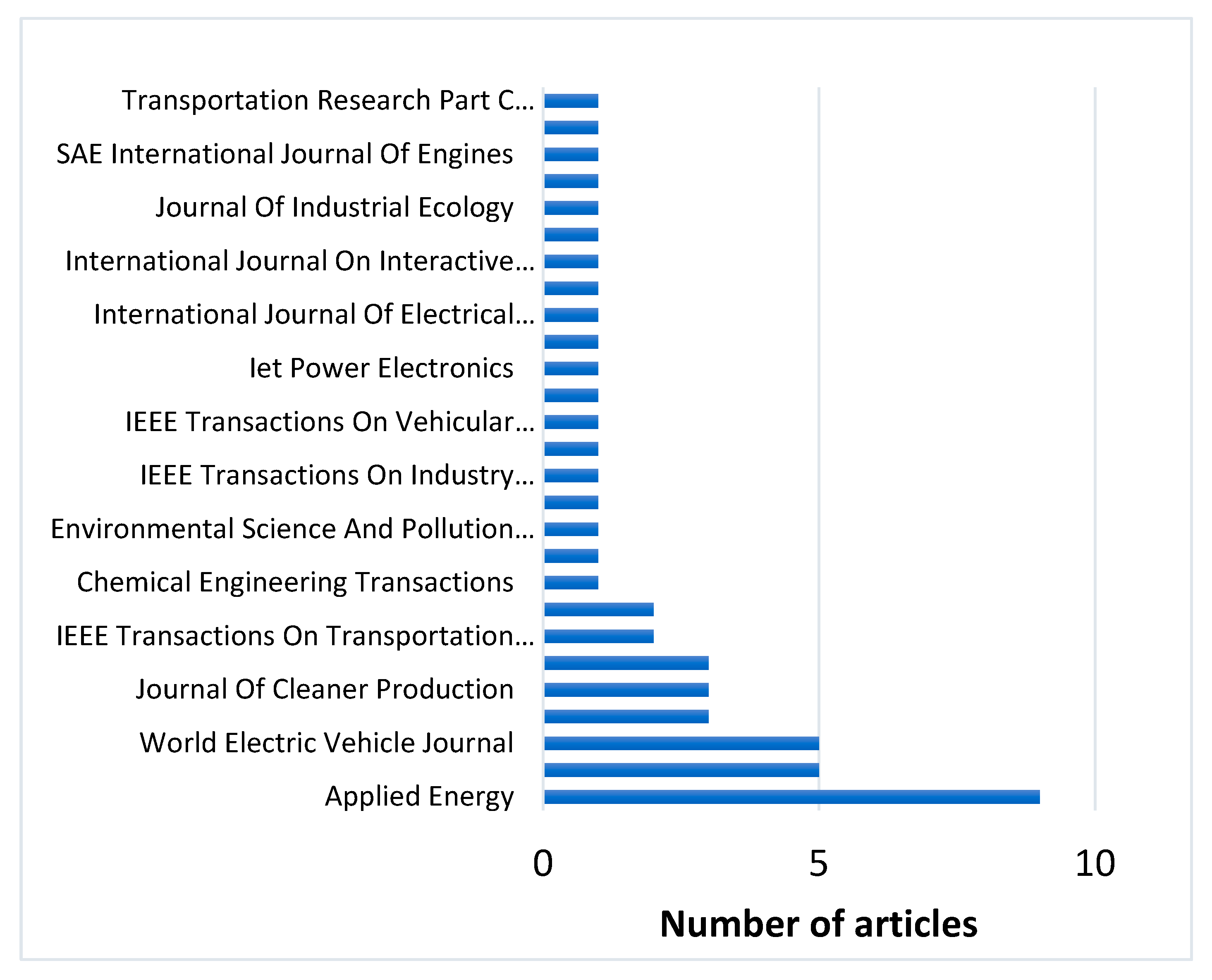
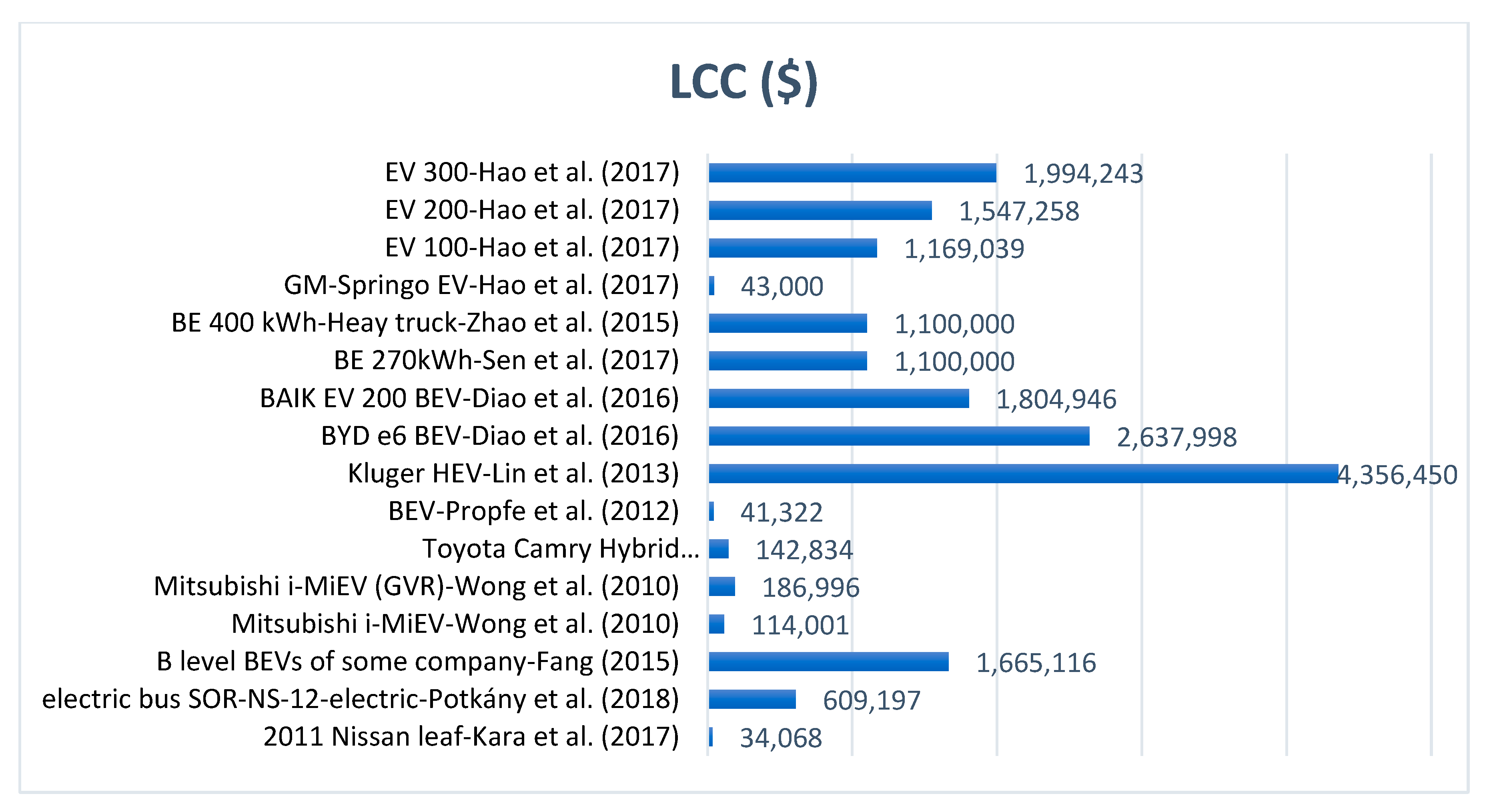
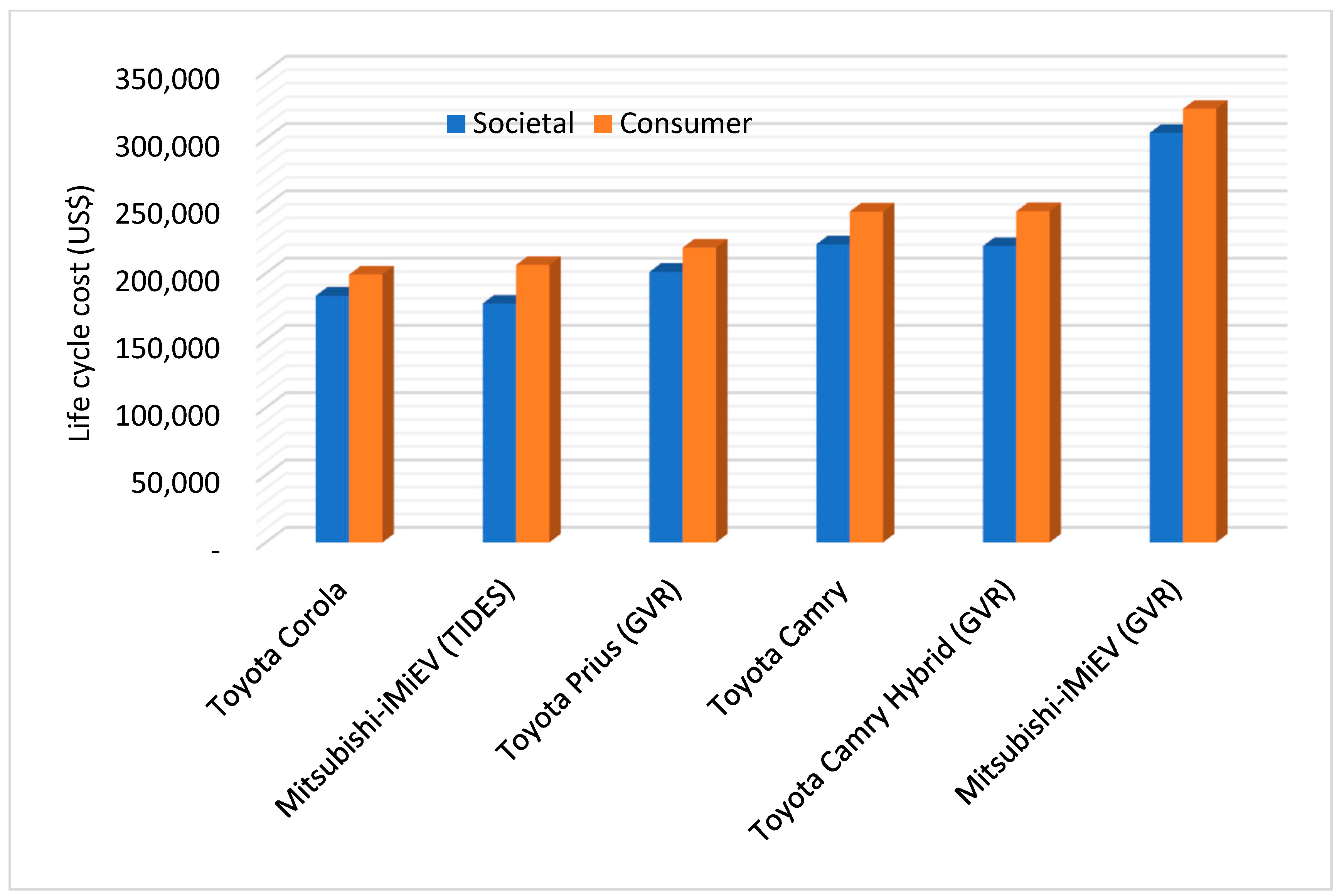
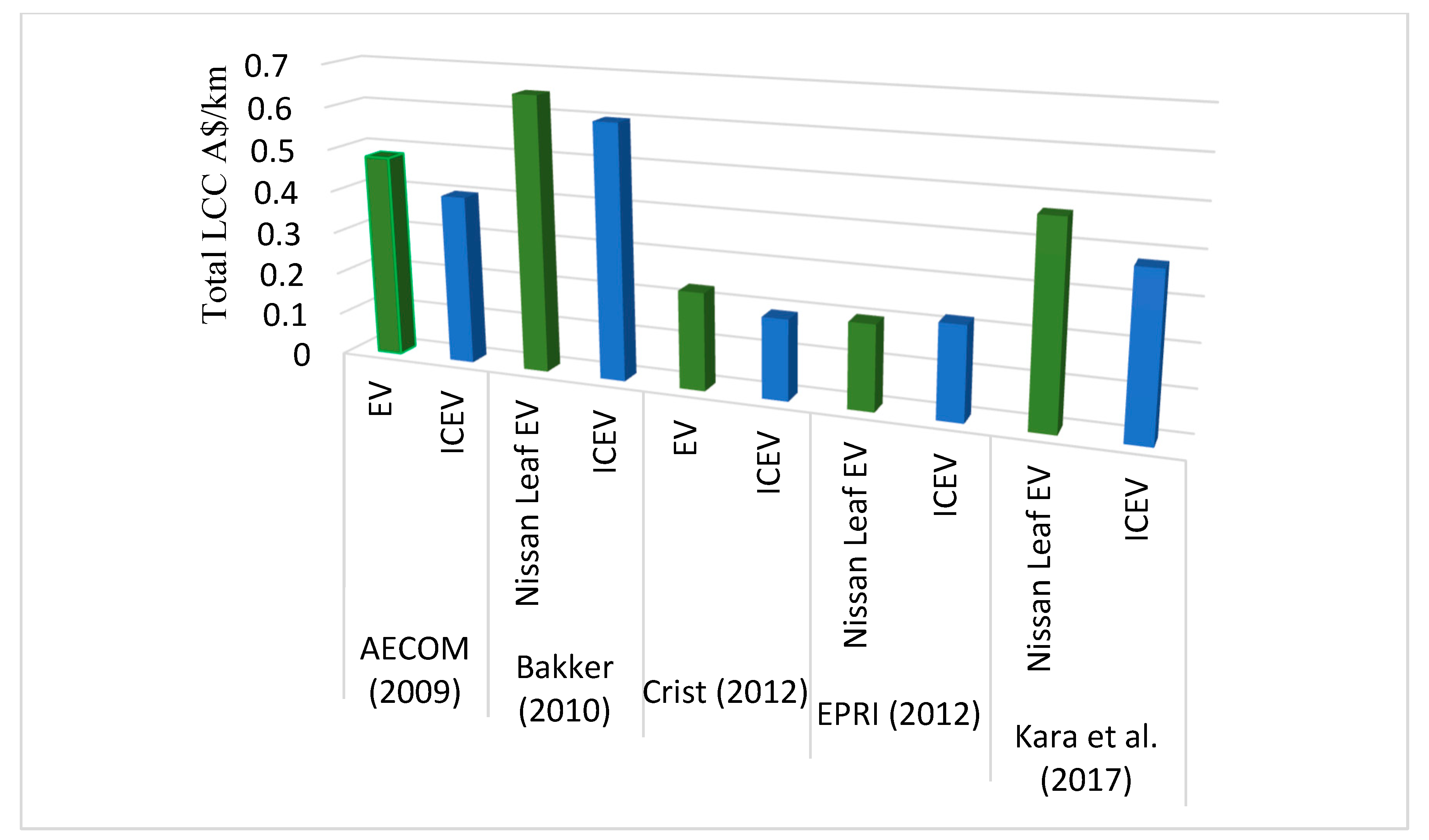
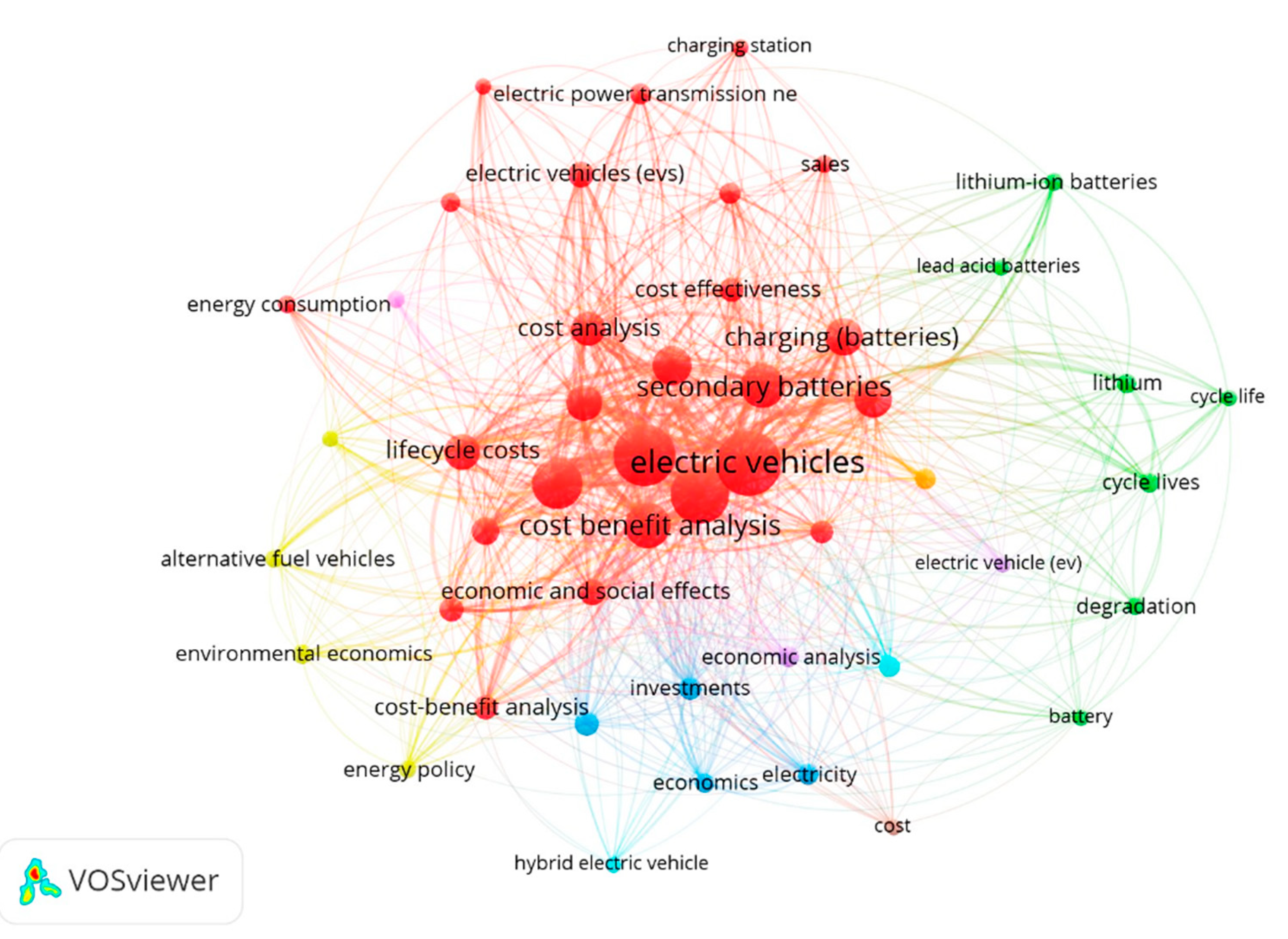
| Article | Journal | Citation | H Index (SJR) | Reference |
|---|---|---|---|---|
| Influence of driving patterns on life cycle cost and emissions of hybrid and plug-in electric vehicle powertrains | Energy Policy | 166 | 178 | [34] |
| Cost analysis of plug-in hybrid electric vehicles including maintenance and repair costs and resale values | World Electric Vehicle Journal | 93 | 13 | [35] |
| Electric vehicles in Portugal: An integrated energy, greenhouse gas and cost life cycle analysis | IEEE | 22 | 250 | [36] |
| Life cycle private costs of hybrid electric vehicles in the current Chinese market | Energy Policy | 52 | 178 | [26] |
| Life cycle private cost-based competitiveness analysis of electric vehicles in China considering the intangible cost of traffic policies | Applied Energy | 31 | 162 | [24] |
| Life cycle cost analysis of different vehicle technologies in Singapore | World Electric Vehicle Journal | 14 | 13 | [37] |
| Energy consumption and cost-benefit analysis of hybrid and electric city buses | Transportation Research Part C: Emerging Technologies | 197 | 100 | [38] |
| Does a battery-electric truck make a difference?—Life cycle emissions, costs, and externality analysis of alternative fuel-powered Class 8 heavy-duty trucks in the United States | Journal of Cleaner Production | 54 | 150 | [39] |
| The economic competitiveness and emissions of battery electric vehicles in China | Applied Energy | 46 | 162 | [40] |
| Electric vehicle cost, emissions, and water footprint in the United States: development of a regional optimization model | Energy Policy | 68 | 178 | [41] |
| Electric vehicles for greenhouse gas reduction in China: A cost-effectiveness analysis | Transportation Research Part D: Emerging Technologies | 34 | 100 | [42] |
| Life cycle environmental and economic impact assessment of alternative transport fuels and power-train technologies | Energy | 28 | 158 | [10] |
| A cost–benefit analysis of electric loaders to reduce diesel emissions in underground hard rock mines | IEEE | 23 | 250 | [43] |
| The development pattern design of Chinese electric vehicles based on the analysis of the critical price of the life cycle cost | Energy Policy | 6 | 178 | [44] |
| A cost-benefit analysis of V2G electric vehicles supporting peak shaving in Shanghai | Electric Power System Research | 104 | [45] | |
| Life Cycle Cost Analysis of Electrical Vehicles in Australia | Procedia CIRP | 12 | 41 | [25] |
| An optimal electric vehicle investment model for consumers using total cost of ownership: A real option approach | Applied Energy | 162 | [46] | |
| Total cost of ownership and externalities of conventional, hybrid and electric vehicles | Transportation Research Procedia | 19 | 17 | [47] |
| Total cost of ownership and market share for hybrid and electric vehicles in the UK, US and Japan | Applied Energy | 90 | 162 | [48] |
| Country | Policies and Legislations | Year |
|---|---|---|
| Canada | Stringent laws on GHG emissions to encourage EVs | 2010 |
| Incentive programs inform of tax rebates and or credit by the provincial government | 2011 | |
| United States | American Recovery and Reinvestment Acts established tax credits for purchasing EVs and conversion kits to retrofit conventionally powered vehicles with EVs capability | 2009 |
| New Corporate Average Fuel Economy (CAFÉ) standards to encourage the expanded market entry of electric drive technologies | 2012 | |
| Spain | Spanish National Policy Framework (MAN)-Framework to develop the EV market. | 2014 |
| Royal Decree 1053/2014: To support the deployment of recharging infrastructure of EVs. | 2014 | |
| Strategic plan (2014–2020) to promote alternative energy vehicles was launched. | 2015 | |
| Incentives for vehicle acquisitions (PLAN MOVEA): This is a new incentive plan for alternative vehicle acquisition. | 2017 | |
| The Netherlands | Special Tax rule: Exemption of EVs from yearly road tax. | 2006 |
| National Action Plan for Electric Driving: This plan was to make the Netherlands an international laboratory for electric driving (2009–2011). | 2009 | |
| Italy | Directive Alternative Fuel Initiative. | 2014 |
| Law on the incentive to purchase EVs. | 2015 | |
| Super amortization law. | 2017 | |
| Switzerland | Bill to limit CO2 emission to 130 g/km: This is to encourage EVs. | 2015 |
| Believed that the introduction of EVs should be driven by market forces. | ||
| Turkey | Vehicle Taxation Measures. | |
| Special consumption tax. | 2016 | |
| An annual vehicle tax. | 2016 | |
| Denmark | Danish EV promotion program: allocated 30 million DKK to promote demonstration programs for battery EVs. | 2008 |
| Establishment of the Center for Green Transport to create a framework for sustainable transport. | 2009 | |
| Edison project for EVs and PHEVs. | ||
| Exemptions of battery EVs from registration tax and annual tax. | 2009 | |
| France | Tax incentives. | 2008 |
| Charging infrastructure working group. | 2010 | |
| Germany | EV-related taxes. | 2012 |
| Portugal | Framework for electric mobility. | 2010 2011 |
| Incentives targeting EVs. | ||
| EV exemptions from vehicle acquisition tax. | ||
| Consumer incentives for EVs. | ||
| Compulsory installation of electric mobility charging infrastructure in parking areas of new buildings. | ||
| Special EVs access to the priority lane, | ||
| Preferential parking area for EVs in urban centers. | ||
| Finland | Vehicle taxations. | 2008 |
| Full exemptions of purchase tax and annual tax for EVs. | ||
| Belgium | Registration tax benefits, ownership tax benefits, company tax benefits purchase subsidies and other financial benefits. |
© 2020 by the authors. Licensee MDPI, Basel, Switzerland. This article is an open access article distributed under the terms and conditions of the Creative Commons Attribution (CC BY) license (http://creativecommons.org/licenses/by/4.0/).
Share and Cite
Ayodele, B.V.; Mustapa, S.I. Life Cycle Cost Assessment of Electric Vehicles: A Review and Bibliometric Analysis. Sustainability 2020, 12, 2387. https://doi.org/10.3390/su12062387
Ayodele BV, Mustapa SI. Life Cycle Cost Assessment of Electric Vehicles: A Review and Bibliometric Analysis. Sustainability. 2020; 12(6):2387. https://doi.org/10.3390/su12062387
Chicago/Turabian StyleAyodele, Bamidele Victor, and Siti Indati Mustapa. 2020. "Life Cycle Cost Assessment of Electric Vehicles: A Review and Bibliometric Analysis" Sustainability 12, no. 6: 2387. https://doi.org/10.3390/su12062387
APA StyleAyodele, B. V., & Mustapa, S. I. (2020). Life Cycle Cost Assessment of Electric Vehicles: A Review and Bibliometric Analysis. Sustainability, 12(6), 2387. https://doi.org/10.3390/su12062387





